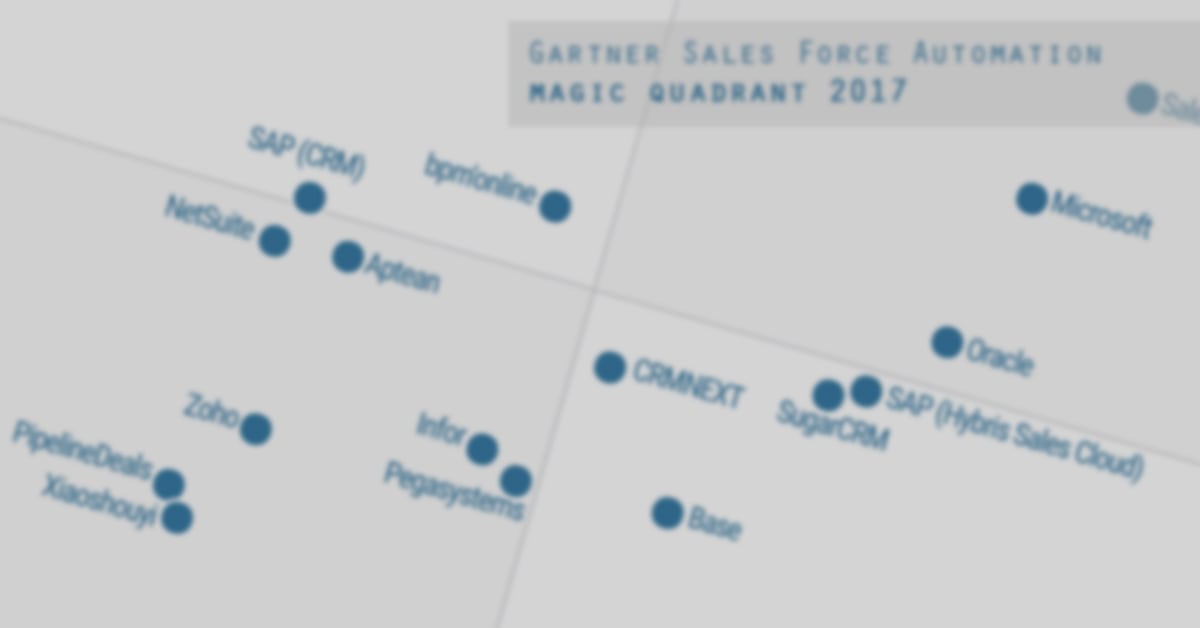09 Aug SugarCRM a visionary of Sales Force Automation
The customer relationship management system from SugarCRM was once again placed at the forefront of market-leading solutions. At eVolpe, we are observing the unshakable SugarCRM’s vision of constant innovation and the endeavor to take over from Salesforce. It makes us believe that in the long run there is no better software out there than Sugar!
Gartner’s Magic Quadrant – what is it?
Gartner releases its Magic Quadrant once a year. The full report is, of course, a very large document (usually over 20 pages). In this article, we will try to summarize the most relevant information regarding its 2017 edition.
The purpose of the survey is to show a specific part of the IT industry and to compare the competition and its flagship products. The report shows relationships between companies and classifies them accordingly to the role they play in the marketplace. It also describes the strengths and weaknesses of each supplier.
The task of analysts at Gartner, in the case of the Sales Force Automation report, was to measure the extent to which key players in the CRM market provide solutions that really support and automate sales processes in modern companies.
CRM system providers along with their flagship products are spread in a four-quarters chart.
The so-called Gartner’s Magic Quadrant is built on the basis of fifteen criteria. Each part represents a different group of vendors: niche players, challengers, visionaries and leaders.
The location of the manufacturer and its system in Gartner’s Magic Quadrant depends, among other things, on the evaluation of innovation, business model, and market understanding. What also counts is the time of reaction, quality of service and the so-called Customer Experience.
The Gartner’s graph is also placed on an axis showing the ability to execute and complete company’s vision.
- The vertical axis called “Ability to execute” determines the capability to implement financial, business and organizational ideas and solutions.
- The horizontal axis – “Completeness of vision” – shows how good and complete the vision of a given market segment is and how well a certain business creates its future in this environment.
Though the most desirable is the square of leaders, Gartner’s analysts emphasize that the remaining squares also have their pros. Challengers are committed to their own development so that they could lead the way as quickly as possible, niche players often offer specialized solutions in order to answer very specific customer needs, visionaries create the future of the industry and only by working with them we will get the warranty of real 21st century solution.
Gartner’s Sales Force Automation 2017 Magic Quadrant
With this year’s edition of Gartner’s Sales Force Automation Magic Quadrant, SugarCRM has been once again voted a visionary of the market! The users appreciate the above-average flexibility and usability of the system, paying particular attention to the interface.

SugarCRM is the only company in this quarter that uses Open Source technology. According to Gartner’s evaluation, Sugar is a system suitable for medium or large companies that are working in B2B model (which requires flexibility and the ability to customize the platform to specific requirements).
SugarCRM continues its development by building a product that is primarily targeted at large companies. It wins more and more projects (including one implementation for over 70,000 users) and strengthens its product with newest features (Customer Journey manager and Workflow module etc.).
Strengths of SugarCRM
- User experience: SugarCRM has accurately thought through the sales user’s experience on browsers and mobile devices, and has integrated contextual insight and intelligence panels throughout the user interface, making it attractive and easy to use.
- Configuration: Reference customers gave SugarCRM strongly positive scores for application reconfigurability, published APIs and technical architecture. In addition, SugarCRM offers multiple deployment options: public cloud, private cloud, and on-premises.
- Implementation partners and application marketplace: SugarCRM has comparatively large numbers of ecosystem partners and add-on apps in its app store, SugarExchange. This reflects its background as a provider of an open-source platform.
The great advantage of SugarCRM (as shown in the study) is the affordable licensing, which on the other hand is also the main complaint against the leader – platform provided by Salesforce. In most cases, the implementation and maintenance of Sugar are less expensive than using the product of its direct competitors.
Although most SugarCRM’s customers are using the services of official regional partners (such as eVolpe), the speed with which the system provider responds to the inquiries was reported to be on a very good level.
To sum up, SugarCRM has maintained a very good place in the Magic Quadrant and continues to be at the forefront of CRM support and sales automation solutions. Considering the growing popularity of the platform and the recent changes, SugarCRM has a great chance to jump to the leader position in the next installment of the SFA Magic Quadrant.




